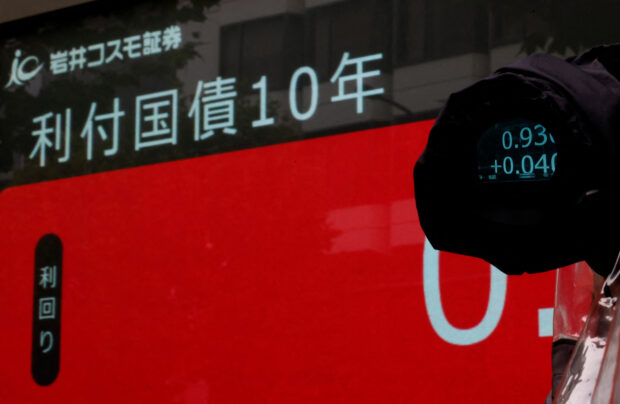BOJ intervenes as JGB yields hit fresh decade highs after YCC tweak

An electronic board outside a brokerage displaying Japan’s 10-year government bonds level is seen on the viewfinder of a TV camera from a local broadcaster, after the Bank of Japan loosened its grip on long-term interest rates, in Tokyo, Japan, Oct 31, 2023. REUTERS/Kim Kyung-Hoon
TOKYO – The Bank of Japan intervened in the government bond market on Wednesday to rein in a jump in yields to fresh decade highs, underlining the challenge for the central bank a day after loosening its grip on long-term interest rates.
The 10-year Japanese government bond yield rose 2 basis points (bps) to 0.970 percent, a level last seen in May 2013, before retreating to 0.960 percent immediately after the BOJ announced an emergency bond-purchase operation.
Japan’s central bank on Tuesday took another small step away from its decade-long commitment to ultra-easy stimulus by changing the 1 percent ceiling for the 10-year yield to a reference point rather than a hard cap.
The monetary authority also removed a pledge to defend the level with offers to buy unlimited amount of bonds, nodding to market forces that have continued to push yields up in line with global moves and domestic inflationary pressures.
Tuesday’s adjustments has made it more likely for there to be “a continued sense of caution in the market that we’re moving in the direction of policy normalization,” said Keisuke Tsuruta, fixed income strategist at Mitsubishi UFJ Morgan Stanley Securities.
Article continues after this advertisementTsuruta sees the tweak as a step toward the BOJ eventually exiting from negative interest rates policy, which he expects around the beginning of next year at the earliest.
Article continues after this advertisementThe two-year JGB yield had ticked up to 0.160 percent, while the five-year yield reached 0.480 percent, levels not seen since 2011.
On the superlong end, the 20-year JGB yield rose to its highest since July 2013 at 1.735 percent.
The 30-year JGB yield was up 3 bps at 1.905 percent.
After Tuesday’s changes, yield curve control is “simplified but effectively dead,” said James Malcolm, UBS currency strategist based in London.
YCC will stay as a framework until negative interest rate policy ends, when the BOJ could replace it with something like a minimum bond purchase target aimed at managing its balance sheet and countering yield spikes, Malcolm said.
“The positive spin is that less overt control should help market function recover,” he added